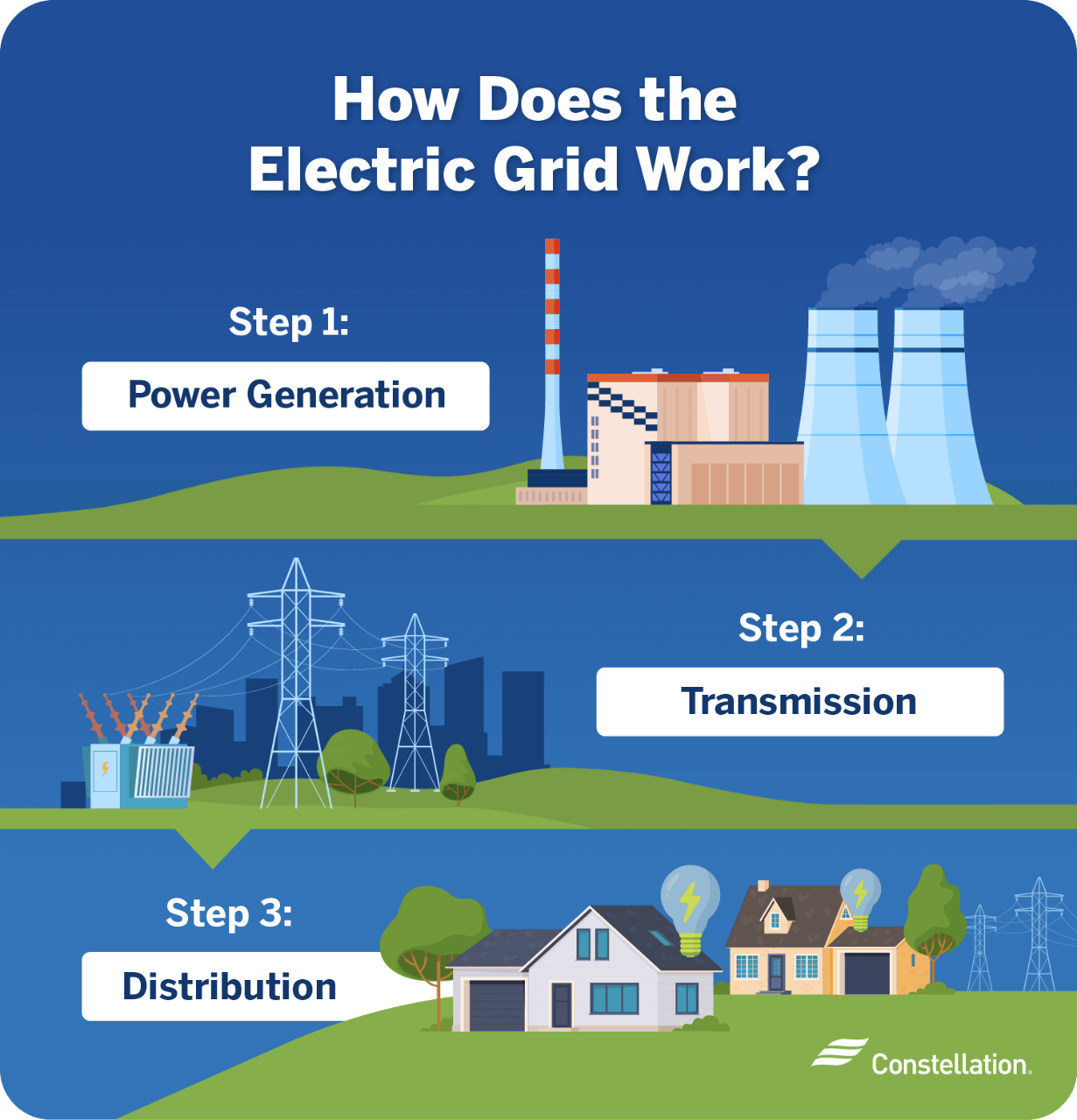What Is a Power Grid and How Does It Work?
- Home Page
- Energy 101: Resources to Help Understand Energy
- Energy Innovation
- What Is a Power Grid and How Does It Work?
It is worth understanding the components of the electrical power grid that makes our daily lives more comfortable, safe and productive. As important as it is, the electric power grid has vulnerabilities. With an understanding of how the power grid works, you may be able to contribute to protecting and improving it.
What Is the Power Grid?
The simple answer is that a power grid is a network of components that generate, transmit, and ultimately deliver electricity to customers.
There’s a difference between energy suppliers vs. utilities:
- Utility companies generate electricity and distribute it, maintaining generation plants, power lines and substations.
- Energy suppliers are an alternative to utility companies. They sometimes own their own power plants or buy electricity at wholesale rates that they then sell to customers at a discount.
The U.S. is served by three grids. The Texas Interconnection is contained within the state of Texas. The Eastern Interconnection covers the eastern U.S. The Western Interconnection covers the mid-mountain and Pacific west, up through Canada. These independent grids interconnect somewhat to share power and serve millions of customers.
How Does an Electric Grid Work?

The heart of any power grid is the means of power generation: power plants and renewable energy sources that generate the electricity to be moved onto the grid.
Transmission is the next element in an electrical power grid. A substation steps up voltage so that electricity can be efficiently sent long distances over high-voltage transmission lines.
Distribution is the next component. To safely bring power to customers, substations step down power to a lower voltage so it can travel over the local utility poles that you see along roads–and lines you may not see buried under ground.
Before entering a home or business, smaller green transformer boxes step down the power even further to the 240V power most customers need.
How Many Power Grids Are in the United States?
The power grids serving the U.S. are the Western, Eastern, and Texas Interconnections. They formed early in the 20th century as individual utilities started to connect to others nearby. Over time, these connections emerged into these three larger blocks. With future investments, bridging the “seams” between the three interconnects, the overall grid will become more robust with resolving technology and political issues.
Why Does Texas Have a Separate Electric Grid?
The separate grid for Texas has its roots in politics. When President Franklin D. Roosevelt signed the Federal Power Act into law in 1935, it gave Washington, D.C. broad regulatory powers over electricity sales crossing state lines. To help keep costs lower for Texans, given the state's coal, oil, and natural gas resources, utility companies kept connections inside state lines and outside the reach of the federal government.
ERCOT, short for the Electric Reliability Council of Texas, manages the Texas grid today. While independence and low energy costs have been beneficial, the Texas grid is less resilient in how it functions during severe weather events or disruptions in power generation.
What Causes Power Grid Failure?
Now that you know some details about how the power grid works, let’s look at a few ways it can fail when conditions aren’t just right.
Most causes of power outages are local, such as when a tree branch falls and breaks a power line. Grid failures are something completely different.
Extremely high demand may overwhelm the system, especially when conditions limit the grid’s generating capacity. This is what happened when snow and ice limited the Texas grid’s generation capacity at a time when very cold temperatures caused a demand spike in 2021. To protect the system from damage, parts of the grid had to be shut down. Rolling blackouts are one way to protect the grid from overloading.
Human interference and natural causes may also shut down the grid. Earthquakes and hurricanes also put the grid at risk. Software bugs and hacking are another concern. When you report a power outage, utilities respond quickly. With advance weather warnings, they can pre-position repair crews for rapid deployment. You can minimize the impact on you and your business by knowing what to do when the power goes out.
What Factors Threaten the Electric Grid?
A secure and reliable power grid is necessary for the safety of people and the economic viability of companies.
The Congressional Budget Office’s latest report, "Enhancing the Security of the North American Electric Grid," enumerates weather event threats like heat waves, blizzards, or hurricanes. Also included in the report is the risk from earthquakes and wildfires.
A high-altitude Electromagnetic Pulse, or EMP, either caused by humans or resulting from a solar storm, is considered to have a high impact, yet a very low likelihood. Cyber attacks are an increasing risk. A physical attack, either local or large-scale and coordinated, is considered the greatest risk.
What Happens if an Electric Grid Goes Down?
Much of modern life depends on electricity. We would see transportation cease, as it would become impossible to pump gas or operate traffic lights, train switches, and air traffic control systems. Businesses, schools, stores, and hospitals would shut down. The financial system would grind to a halt. Cell phone communication, cable, and broadcast would mostly cease, as well.
Given the consequences, power grids, utilities, and energy suppliers have been working on ways to protect the grid, make it more resilient, and make repairs quickly.